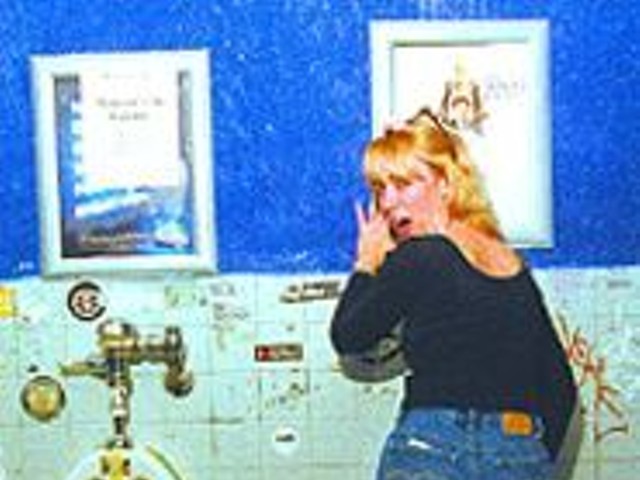As James Neton stood at the podium in an Adam's Mark Hotel ballroom in late October, it wasn't just the twelve members of the Advisory Board on Radiation and Worker Health, seated around white-clothed tables arranged in a U, who gave the health physicist their undivided attention. Gathered behind the board members was an audience that included priests, activists, policy analysts, a staffer from Senator Kit Bond's office, a Missouri Department of Natural Resources division director, members of the local grassroots group United Nuclear Weapons Workers and, most tellingly, former employees who worked with radioactive materials at the Mallinckrodt Chemical Company and family members of Mallinckrodt workers who have passed away.
Neton, an administrator with the National Institute for Occupational Safety and Health, was in town to unveil a government report on Mallinckrodt's downtown location, which during the 1940s and '50s supplied purified uranium needed to build atomic bombs. The advisory board is responsible for administering a federal program to compensate workers who have suffered illnesses related to their involvement in the production of nuclear weapons. The purpose of the 125-page report, called a "site profile," is to re-create working conditions so that researchers can reconstruct how much radiation each worker was exposed to. (For more about the Mallinckrodt workers' plight, see the August 13 Riverfront Times cover story "Nuclear Half-Lies".)
The Mallinckrodt profile describes the work that went on from 1942 to 1957 in approximately 60 buildings at the plant near North Broadway and Destrehan Street, the types of material workers handled, and the radiation doses they may have been exposed to. Additionally, the profile describes radioactive waste generated at the site and accidents that took place there.
"I would characterize it as a fairly dirty operation, and the controls were really not there in the very early days," Neton said.
Although radiation from uranium posed a danger to workers, byproducts released from pitchblende ore shipped in from the Belgian Congo were even deadlier. Some workers who handled the material, Neton said, were exposed to radon levels "800 times the allowable concentrations levels back then -- which would be 2,400 times the current allowable concentration in U.S. facilities."
The fact that Neton's comments were dressed up in scientific lingo didn't lessen their impact on the assembled workers and their families. And the report he helped prepare contained many more revelations that weren't mentioned on that October day:
· In the 1940s Mallinckrodt employees downtown were scooping uranium dust out of filters and furnaces with their hands. For ten years laundry workers at Mallinckrodt washed more than 50,000 coveralls, handkerchiefs and underwear coated in radioactive dust before any attempt was made to decontaminate the garment area.
· In 1949 the company sent three million gallons per day of "liquid effluent" containing up to twelve pounds of uranium straight into the Mississippi River. By 1956 the sewers were carrying away 12,000 gallons per day of pitchblende raffinate, the waste left over after uranium is extracted from the highly toxic ore.
· The site profile list refers to old government reports that estimate that in the early years, Mallinckrodt stacks belched out about 52 tons of uranium.
But perhaps most disturbing of all is a reference, deep in the footnotes of the site profile, to a top-secret report that was prepared in 1950 by the U.S. Atomic Energy Commission (AEC), declassified in 1954 and recently obtained by the Riverfront Times. The 26-page document, dated November 20, 1950, is titled "An Estimate of Cumulative Multiple Exposures to Radioactive Materials, Mallinckrodt Chemical Works, Plants 4 and 6, July 1942 to October 1949." On the cover is a stamp warning that disseminating the report without authorization affects "the National Defense of the United States" and is subject to criminal penalties. The pages are stamped "SECRET." And the contents clearly indicate that management at Mallinckrodt -- which received a copy of the report at the time it was prepared -- knew back in 1950 that they were exposing workers to extremely high radiation doses.
According to the report, the wearing of badges to detect radiation wasn't initiated until 1946, and use was spotty even after that. Dust measurements weren't performed until 1948, breath-radon determinations in 1947. "It is proper to assume that exposures prior to the dates where information became available were at least as severe as they were found at the time of our initial study," the authors wrote.
In 1947, the report notes in chillingly detached prose, the AEC's predecessor was already aware of "considerable" potential hazards to workers. "It was recognized that pending elimination of excessive exposures, here was an unique opportunity to conduct clinical studies on a fairly large size population whose radiation exposure had been considerably in excess of any group for which data are available," the report reads.
For the purposes of their own study, the authors write in another section, "we have taken advantage of the availability of two autopsies and one biopsy from individuals having known uranium exposure."
The individuals were workers at Mallinckrodt. According to the report, J.H. worked in various operations for 43 months. Nine weeks after he was terminated, J.H. died from stomach cancer. The autopsy found uranium in three bone samples. Another worker, J.B., worked in the uranium operation for 24 months. He died of tuberculosis ten months after he was terminated. An autopsy revealed uranium still in his lungs and suggested high levels of exposure while he worked in the plant, as well as uranium in all five bone samples. A living worker was biopsied. And though the reason for the procedure isn't given, the authors write that there was uranium in his bone.
The report concludes that "the skin and bone exposures are relatively insignificant compared to the lung exposure.... It is seen, however...that even if the estimated lung exposure were to be reduced by one order of magnitude, there would still be considerable excessive exposure according to our present standards."
The report was authored by Hanson Blatz and Merril Eisenbud, the latter of whom was the first safety director for the New York Operations Office of the Atomic Energy Commission. In another top-secret memo dated January 31, 1951, Eisenbud notes that seventeen Mallinckrodt workers had had their lungs exposed to radiation doses exceeding 1000 rem. The allowable annual limit for radiation to the lung in the 1950s was 15 rem.
Eisenbud's 1951 memo indicates that there was already concern about the potential for legal action on the part of Mallinckrodt workers who'd been exposed to radiation. "About a year ago, you asked if it would be possible for us to estimate our 'potential liability' among the long term Mallinckrodt employees," he writes, going on to say that the question is a "knotty problem" for which he does not have an answer.
Eisenbud mentioned his Mallinckrodt work more than 40 years later in an oral history, but although it has been declassified for nearly 50 years, the report wasn't produced to St. Louis activist Denise Brock when she specifically requested it more than eight months ago under the federal Freedom of Information Act (FOIA). It wasn't until early this month, when Richard Miller, a policy analyst with the Washington, D.C.-based Government Accountability Project saw the report listed in Neton's site profile and filed a FOIA request for the papers, that the documents were finally released.
Miller compares some of the revelations to the human experimentation that took place in concentration camps during World War II. "The distinction between this and what Dr. Mengele did -- there really is not much of a distinction," says Miller. "You've basically said, 'Okay, we know we're overexposing workers, what an interesting clinical study this will make. We're giving them in excess of 1000 rem to the lung, let's see what happens.'"
Kay Drey, a longtime anti-nuclear activist, concurs. "As a person who has worked on this for 29 years, I guess I get more upset and angry -- upset and angry about not letting people know about it," says Drey. "This is human experimentation."
"I'm disgusted and sickened and just appalled at what a huge company and what a government can do to a worker," says Brock, the outspoken advocate for Mallinckrodt workers and director of United Nuclear Weapons Workers. "And all in the name of the national welfare, when it is really all in the name of liability and money."
Indeed, although Mallinckrodt officials were aware by 1950 that radiation at the St. Louis plant had hit unacceptable levels, working conditions continued to be hazardous.
"I would characterize this as a fairly messy operation even in the '56 time frame," Neton told his audience in October. According to the site profile, AEC inspectors in 1954 found uranium film on "supposedly clean drums" and observed green dust clouds escaping from cans covered by lids. Inspectors "repeatedly noted hand-scooping going on until the end of the operations at the plant, often due to failure of equipment." A 1955 report indicates that the glove program "for contact with radioactive material was said to be sketchy and inadequate, implying that use of gloves was not consistent."
AEC reports prepared in 1958 revealed that dust continued to be a problem in the plants, with levels sometimes reaching 50 to 100 times the maximum allowable concentrations. Still, the use of respirators "was not acceptable practice." A report prepared in 1955 indicated that even though Mallinckrodt was supposed to sample emissions at least once a year, those inspections were not taking place.
No one ever sued Mallinckrodt, which is now a division of Tyco International Ltd. That's because by law, the workers-compensation system is the exclusive remedy for injured employees. In Missouri, the statute of limitations is two years after the injury or death. While the federal Energy Employees Occupational Illness Compensation Act of 2000 allows sick workers to be eligible for workers-compensation plans if a panel of physicians concludes their illnesses are linked to exposure to toxic substances, cooperation is optional and only fourteen states have signed on to the program. Missouri isn't one of them.
Mallinckrodt workers are counting on another facet of the 2000 legislation, which entitles nuclear-weapons workers (or their families, if the worker is deceased) to a flat payment of $150,000 if they develop a cancer linked to radiation. So far 364 claims for the downtown site have been filed. Of those, only one has been paid. The delay is due to the fact that before a worker can be paid, the government must determine not only whether his illness is covered in the act, but also his precise dates of employment and what his duties involved. This, in turn, is complicated by the lack of company records pertaining to Mallinckrodt workers or data from the site between 1942 and 1948.
All of which brought James Neton to the Adam's Mark last month. At the meeting, Neton announced that the government will use "surrogate worker" data and time-weighted data from later periods in order to determine exposures during periods for which no records exist.
Denise Brock is less than optimistic. "They are going to extrapolate and speculate, when they don't have a clue," she scoffs. Brock notes that under the federal legislation, the government could streamline the process for anyone who worked at Mallinckrodt during the period for which no data exists, if they have any of 21 specified types of cancer. Workers at four other facilities around the nation have been compensated under those guidelines. But suffering from one of those cancers wouldn't be the only hurdle: Mallinckrodt workers would also have to prove they worked at the facility for a minimum of 250 days.
"It's rough justice," Brock admits of the streamlining guidelines. "But at least it's something."
Correction published 11/19/03:
In the original version of this story, the Government Accountability Project was erroneously located. The above version reflects the corrected text.





